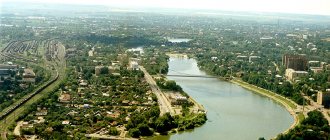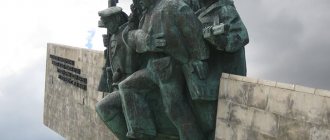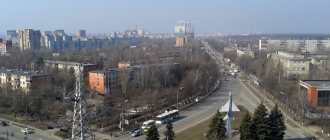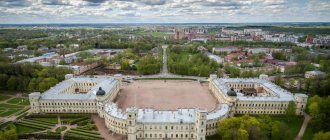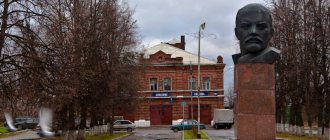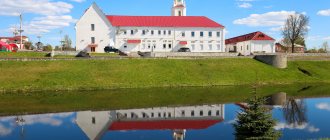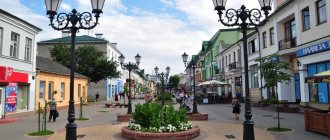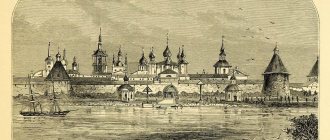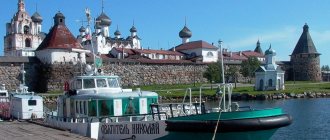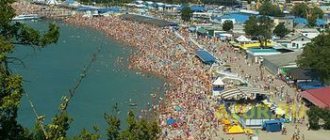Saransk is an ancient city in the Middle Volga region, the capital of the Republic of Mordovia. Saransk arose in 1641 as a fortress for military purposes. This fortress was part of a fortified line on the Atemar abatis line, stretching from Belgorod to Simbirsk. Saransk received city status only in 1780.
We have prepared descriptions and photographs of attractions, interesting and beautiful places, museums that you can visit in Saransk, so that you can finally confirm your desire to visit the city and plan your route.
All the most important things worth visiting in Mordovia besides Saransk.
Foundation of the Saransk fortress, monument
Address: st. Moskovskaya (fountain descent)
The fortress that gave rise to the famous city was called Saransk Ostrozhek. Its location was on the banks of the Insar River at the mouth of Sarley (Saranka). The word “sara” means a wetland, hence the name of first the fortress, and then the city, which later became the capital of the republic.
In 1982, a sculptural composition was installed in Saransk in honor of the first founders of the city; in the 17th century, a watch tower of the fortress was located on this site. The monument will tell about the original history of the city, when the brave inhabitants of the fortress guarded the borders of the Russian state.
Urban areas
Saransk is the capital of the Republic of Mordovia, as evidenced by inscriptions in three state languages - Russian, Erzya and Moksha, often differing from each other only in the endings of words.
The region number is 13, which locals say symbolizes his bad luck.
Saransk is divided into three districts with standard Soviet names: Leninsky, Proletarsky and Oktyabrsky. But among the people these names are not used, but Center, South-West, Svettekhstroy and Khimmash are known. There is even a rhyme about this:
The bosses live in the Center,
In the South-West are their nephews,
At Svettekhstroy - the people themselves,
And on Khimmash there is all sorts of rabble.
All the main attractions of Saransk are located in the Center, which has a clear rectangular system of streets running from north to south and from west to east. The remaining areas were built in the 60s - 80s of the 20th century, are almost identical to other new buildings of that time and are not of particular interest. It is enough to visit one typical microdistrict of the former Soviet Union, built up with 5-9 storey buildings, to know what the rest look like.
Cathedral of Fyodor Ushakov
Address: st. Sovetskaya, 53 Phone: Website: sobor-ushakova.ru
Construction of the Fyodor Ushakov Cathedral lasted from 2002 to 2006, after the patron of the sacred place, Fyodor Ushakov, was chosen in 2001. Admiral and naval commander Ushakov did not lose a single battle in a naval battle, was the founder of sailing fleet tactics, and at the beginning of the 21st century was canonized.
The cathedral is made in a rich Empire style, the height of the dome, made in the non-Byzantine style, is 62 meters including the cross, 12 bells of the cathedral are cast using ancient technologies. Inside the temple there is an iconostasis made of gilded wood. Three altars are dedicated to Fyodor Ushakov, Seraphim of Sarov, and the Mordovian martyrs.
What to bring from Saransk
Souvenirs from Saransk can be divided into three groups:
- traditional ones that can be bought in any city - magnets, plates and mugs with the sights of Saransk;
- gastronomic - products and drinks that are famous for their quality outside of Mordovia. These include the products of three factories: the Saransk Distillery, the Saransk Cannery, and the Lamzur Confectionery Factory. You can also buy horse sausage (makhan) and good quality honey in Mordovia.
- national - Mordovian embroidery, Tavlina decorative wood carving, Mordovian felt boots and wickerwork (bast shoes, birch bark products), Mordovian fairy tales with interesting illustrations and Mordovian dolls in national costumes.
Museum of Fine Arts named after S. D. Erzya
Address: st. Kommunisticheskaya, 61 Phone: Website: erzia-museum.ru Opening hours: Tuesday - Sunday from 9.00 to 18.00 Cost: free for children under 7 years old, for schoolchildren - 20 rubles, for students - 50 rubles, for other visitors - 150 rubles.
The Mordovian Museum named after S. D. Erzya is a particularly valuable object of cultural and national heritage of the peoples of the Republic of Mordovia. The museum has received numerous awards; over the years of its activity, the complex has made a significant contribution to the development of the culture of Mordovia and the country as a whole, and contributed to the revival of national art.
The museum presents works by artists Stepan Erzya, Fedot Sychkov, Ivan Makarov, as well as collections of Russian art, contemporary art of Mordovia, modern domestic, decorative and folk art.
Tavlinsky carved toys
Tavlinsky carved toys made of unpainted wood became a symbol of Mordovia.
Tavlinskaya toy
In the Erzyan village of Podlesnaya Tavla (Kochkurovsky district of the Republic of Mordovia) there is a children's experimental wood carving school. It was created in the 70s of the last century. The founder of the school is Nikolai Ivanovich Mastin. At first it was just a wood carving club at a school; now the carving school is located in a separate building along with the Tavlina toy museum.
Tavlinsky toys became known far beyond the borders of Mordovia, the most popular being Tavlinsky horses. The peculiarity of the toys is their unique execution style:
- disproportionate, stocky figures of people;
- jewelry-made details of things and objects;
- and of course, Mordovian patterns.
Where can I buy
You can buy Tavlina toys in the village of Podlesnaya Tavla or in souvenir shops in Saransk.
Museum of Local Lore named after I.D. Voronina
Address: st. Moskovskaya, 48 Telephone: Website: www.mrkm.ru Opening hours: Tuesday - Sunday from 10.00 to 18.00 Cost: preschoolers - 20 rubles, schoolchildren and students - 35 rubles, other visitors - 80 rubles, free entry for certain groups of citizens.
The history of the Mordovian local history museum began back in 1918, when at a meeting of the Saransk education department it was decided to organize a county museum. In 2005, the museum was given the name of Ivan Dmitrievich Voronin, the founder of scientific local history of Mordovia, writer and public figure.
In the local history museum you will see a repository of unique historical relics; its collections include ethnography, numismatics, books, weapons, decorative and household items, church items, watches, furniture, musical instruments, painting and sculpture. The pride of the local history museum is a treasure trove of silver coins made in the 14th and 15th centuries.
Candies
Saransk confectionery factory "Lamzur" makes delicious candies, cookies, marshmallows, toffee and waffles. From the original one can be noted: a set of chocolates “Orthodox Mordovia” in the form of a book-box. On the cover, the main Orthodox symbol of Mordovia is the Ushakov Cathedral. On the spread are photographs of Mordovian monasteries.
Museum of A.I. Polezhaeva
Address: st. Saranskaya, 51 Telephone: Opening hours: from 10.00 to 17.00 Cost: free
The museum was opened in 2001 in honor of the 350th anniversary of the city; it was named after its famous fellow countryman Alexander Ivanovich Polezhaev. A.I. Polezhaev is a favorite poet of the townspeople of Saransk; in tsarist times, his works were banned by censorship for a long time.
The museum is located in a village house, but includes several halls, the compositions of which are associated with the fate and life of Alexander Polezhaev. You will learn about the poet's childhood, his youth and maturity, and see rare things that belonged to the family of A. Polezhaev.
Interesting facts about Saransk
Fact 1. Founded as a guard fortress, Saransk immediately began to grow at a rapid pace, and in just 10 years it had already received the status of a city, albeit a county one. They named it after the Saranka River, the name of which, in turn, comes from the Mordovian word “sara”, which means “swampy floodplain”.
Fact 2. During the peasant uprising of Stepan Razin, the troops of the rebel ataman captured Saransk, which became one of their main bases. The city supplied the rebels with food and other supplies for several months, until the tsarist army recaptured it. At that time, about 4,000 people lived in Saransk.
Fact 3. Stone buildings began to appear en masse in Saransk only in the middle of the last century, after the Great Patriotic War. In the 19th century, the city was practically destroyed three times by powerful fires, each of which caused enormous damage to it - hundreds of houses burned down, that is, almost all that were then in the city. Each time after the fires the city was rebuilt.
Fact 4. Revolutionary sentiments were in the air in Saransk long before the October and February revolutions. Back in 1906, an uprising took place here, in which several hundred people took part. With the help of the local gendarmerie, it was suppressed, but soon the rebels fought back, and after the revolution, Saransk became one of the centers of formation of the Red Army.
Fact 5. During the difficult years of the Great Patriotic War, about 17,000 residents of Saransk took part in the hostilities, and about 50% of them never returned home. This figure becomes even more impressive if we remember that only about 42,000 people lived in the entire city at that time.
Fact 6. The Saransk development plan was approved personally by Catherine II, and thanks to it, the city received a rectangular street network, convenient and practical, like modern cities. Now the city has more than 450 streets and alleys - almost twice as many as, for example, in Cherepovets, which is home to almost the same number of people.
Fact 7. Now about 320,000 people live in Saransk, which is about 40% of the population of all Mordovia. If this city were an independent state, it would rank 185th in population among all countries in the world, between Iceland and Vanuatu.
Fact 8. The Mordovian capital has a rather mild climate; there has never been heat above +36.1 °C or frost below -36.1 °C - a direct mirror coincidence. Although winters here are usually quite cold, and summers can be dry and hot. What to do - continental climate.
Fact 9. Modern technologies began to appear in Saransk in the 30s of the 20th century. It was then that the city began to cover sidewalks and roads with asphalt in some places, and at the same time a new public transport appeared - the first buses. Around the same years, the first buildings with a height of more than 2 floors began to be built here, and by the beginning of the Great Patriotic War, a railway station was opened in the city.
Fact 10. A hundred years ago, most of the local population was illiterate.
At that time, no one was particularly concerned about education in Saransk, and there were only a few educational institutions here. But the situation quickly began to improve, and already in the first years after the revolution, more than half of all townspeople were taught to read and write. A lot of time has passed since then, and for a long time in Saransk this figure has been about 100%. Did you like the article? Share with your friends!
Memorial Museum of Military and Labor Feat
Address: st. Sovetskaya, 36 Phone: Website: patriotrm.clan.su Opening hours: Tuesday - Sunday from 10.00 to 17.00 Cost: free.
The Memorial Museum in Saransk was opened in 1995 on the 50th anniversary of Victory Day. The museum has several exhibition halls: the hall of fame, the hall of commanders, the “Continuity of Generations” hall, and the “Fiery Front Roads” hall. The museum contains a large number of military books, original diaries of soldiers and letters from the front, awards and weapons, personal belongings of soldiers and commanders. The facade of the building is made in strict black and orange tones, which form the symbol of the Great Victory - the St. George's ribbon.
If you are interested in military history, visit Kursk and its military museum.
Monuments of religious architecture
In a city with a population of more than 300 thousand people, enough churches and cathedrals have been built to make believers feel comfortable. Saransk churches, built in different historical periods, are not inferior in beauty to the religious buildings of Ryazan or Kazan.
Church of St. Nicholas the Wonderworker
- Opening hours: daily, from 7:00 to 19:00.
- Telephone.
- Address: st. Volgogradskaya, 90. Transport stop “St. Nicholas Church”.
By the end of the 19th century. two wooden churches of Posopskaya Sloboda are completely dilapidated. As a result, the decision was made to build a stone church for numerous parishioners. It was consecrated in 1906, after the completion of construction work that lasted 9 years. The red brick building, topped with massive domes with onions, immediately became one of the main attractions of Saransk. The St. Nicholas Church survived the era of persecution of religion relatively well, since the Museum of Rare Books settled there. The building was returned to believers in 1990. After restoration work, it looks great.
Church of St. John the Evangelist
- Opening hours: daily, from 7:00 to 19:00.
- Telephone.
- Address: st. Democratic, 28. Transport stop "Museum of S. Erzya".
The temple, consecrated in 1693 in the name of John the Evangelist, is not only a revered religious building in Saransk, but also the oldest building in Mordovia in general. The architecture of the church, which was originally visited by numerous inhabitants of Streletskaya Sloboda, is traditional for that era. Five blackened domes, topped with decorative domes, rise above the white stone building. A two-tier bell tower was erected nearby, connected to the main volume of the refectory. The facade of the temple is decorated with an arcature belt, carved kokoshniks and window frames. The building is included in the register of cultural heritage sites of the Russian Federation.
Trinity Church
- Opening hours: daily, from 7:00 to 19:00.
- Telephone.
- Address: st. Volodarsky, 55. Transport stop “Trinity Church.
The Trinity Church, erected at the request of the Saransk Cossacks and consecrated in 1700, is now part of the courtyard of the Mother of God Nativity Monastery. When designing the temple, they used a solution characteristic of the architecture of that time, placing an octagon with a drum topped with an elegant dome on a massive quadrangle of the first tier. A three-tier bell tower with light arched windows was erected nearby. In 1931, the church was closed by decision of the authorities. Within its walls were workshops for various industries. After restoration carried out at the end of the last century, the building was transferred to the monastery.
Monument to Patriarch Nikon
Address: Cathedral Square
In 2006, a first-of-its-kind monument to Patriarch Nikon, the patriarch who began the schism of religious Rus', was erected on Cathedral Square in Saransk. Patriarch Nikon was awarded this honor for his greatness of spirit and courage in establishing order in the Russian Orthodox Church, for his desire to work for the good of the Faith and the people.
The monument is a tall monument depicting a righteous, strict and fair patriarch who reads the news of the new law to the people.
Printed products
In Mordovian book and souvenir shops you will find:
- books about the history of Mordovia, its nature, national costumes, life and epic;
- biography and book-albums of works by the famous sculpture Stepan Erzya;
- reproductions of paintings by the Mordovian artist F.V. Sychkov;
- icons of the most revered Mordovian saint, Admiral Fyodor Ushakov;
- Mordovian phrase books, which guests of Saransk will not need, since almost the entire population of Mordovia speaks Russian.
One of the interesting books is original Mordovian folk tales with interesting graphic illustrations by Peter Alekseev. Fairy tales will be interesting for both children and adults.
Monument to Emelyan Pugachev
Address: st. Korolenko
A memorable historical event for Saransk was the stay of Emelyan Pugachev in it in 1774; on July 26 of this year, the rebel commander brought a decree on preparing a worthy meeting for Tsar “Peter III”. The next day, the city nobility and crowds of people greeted Pugachev with all honors, hoping for a better life.
In 1974, at the fork of Volgogradskaya and Korolenko streets, a fort with cast iron cannons was installed, and in 1985, a full-length monument to Emelyan Pugachev was erected on it.
Vodka
Saransk vodka
For many years, the most popular Saransk souvenir for adults has been vodka. It is produced at the distillery. Mordovian vodka is famous for its quality and interesting design. The most original copy of the distillery is Vastoma vodka (meeting). It is produced in three types: regular, on a stand and in a musical tube.
The vodka range is varied, both for regular products and for premium ones. There is Mordovian whiskey “Royal Fox”, balsam “Mordovsky” and Sangvini” - either vermouth or martini.
By the way, the symbol of Saransk, the fox, is also the symbol of the Saransk Distillery.

